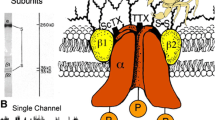Abstract
-
1.
Veratridine induces membrane potential oscillations in non-excitable glioma cells, which are not affected by ouabain (2 mM) or by D600 (0.1 mM). In the presence of veratridine, scorpion toxin causes depolarization of the glioma cells to a positive value of the membrane potential. These effects of veratridine and of scorpion toxin are observed in Na+ but not in choline medium and are inhibited by tetrodotoxin.
-
2.
The response of the glioma cells to bradykinin has also been studied during these experiments. Previously bradykinin has been shown in these cells to induce a hyperpolarizing response caused by an increase in K+ conductance. This response to bradykinin can still be seen during the veratridine-induced oscillations of the membrane potential.
-
3.
In the glioma cells the uptake of guanidinium, a substitute for Na+, is enhanced by veratridine plus scorpion toxin. This stimulation is tetrodotoxin-sensitive.
-
4.
However, in the excitable neuroblastoma x glioma hybrid cells studied for comparison, veratridine causes membrane potential oscillations accompanied at the rising phase by one action potential or a train of action potentials.
-
5.
The results demonstrate that in non-excitable glioma cells tetrodotoxin-sensitive Na+ channels can be activated by veratridine and by scorpion toxin.
Similar content being viewed by others
References
Amano T, Hamprecht B, Kemper W (1974) High activity of choline acetyltransferase induced in neuroblastoma x glia hybrid cells. Exp Cell Res 85: 399–408
Catterall W (1981) Studies of voltage-sensitive sodium channels in cultured cells using ion-flux and ligand-binding methods. In: Nelson PG, Lieberman M (eds) Excitable cells in tissue culture. Plenum Press, New York, pp 279–317
Fleckenstein A (1977) Specific pharmacology of calcium in myocardium, cardiac pacemakers and vascular smooth muscle. Ann Rev Pharmacol Toxicol 17: 149–166
Hamprecht B (1974) Cell cultures as model systems for studying the biochemistry of differentiated functions of nerve cells. In: Jaenicke L (ed) Biochemistry of sensory functions, 25th Mosbacher Colloquium der Gesellschaft für Biologische Chemie. Springer, Berlin, Heidelberg, New York pp 392–423
Hamprecht B (1977) Structural, electrophysiological, biochemical and pharmacological properties of neuroblastoma-glioma cell hybrids in cell culture. Int Rev Cytol 49: 99–170
Heumann R, Reiser G, van Calker D, Hamprecht B (1982) Polyploid rat glioma cells: production, oscillations of membrane potential and response to neurohormones. Exp Cell Res 139: 117–126
Hille B (1972) The permeability of the sodium channel to organic cations in myelinated nerve. J Gen Physiol 58: 599–619
Jacques Y, Fosset M, Lazdunski M (1978) Molecular properties of the action potential Na+ ionophore in neuroblastoma cells. J Biol Chem 253: 7383–7392
Kao CY (1966) Tetrodotoxin, saxitoxin and their significance in the study of excitation phenomena. Pharmacol Rev 18: 997–1049
Munson R, Westermark B, Glaser L (1979) Tetrodotoxin-sensitive sodium channels in normal human fibroblasts and normal human glia-like cells. Proc Natl Acad Sci USA 76: 6425–6429
Pouysségur J, Jacques Y, Lazdunski M (1980) Identification of a tetrodotoxin-sensitive Na+ channel in a variety of fibroblast lines. Nature 286: 162–164
Reiser G, Heumann R, Kemper W, Lautenschlager E, Hamprecht B (1977) Influence of cations on the electrical activity of neuroblastoma x glioma hybrid cells. Brain Res 130: 495–504
Reiser G, Hamprecht B (1981) The effect of bradykinin on the membrane potential of polyploid glioma cells and neuroblastoma x glioma hybrid cells. Pflügers Arch 389 Suppl: 1224
Reiser G, Hamprecht B (1982a) Bradykinin induces hyperpolarizations in rat glioma cells and in neuroblastoma x glioma hybrid cells. Brain Res 239: 191–199
Reiser G, Hamprecht B (1982b) Veratridine activates “silent” sodium channels in non-excitable glioma cells. Pflügers Arch 394 Supp: R 48
Reiser G, Hamprecht B (1982c) Differential effects of various cAMP-derivatives on the morphological and electrical maturation of neuroblastoma x glioma hybrid cells. Exp Cell Res 141: 498–503
Reiser G, Günther A, Hamprecht B (1983a) Blockade by neurotransmitter antagonists of veratridine-activated ion channels in neuronal cell lines. J Neurochem 40: 493–502
Reiser G, Löffler F, Hamprecht B (1983b) Tetrodotoxin-sensitive ion channels characterized in glial and neuronal cells from rat brain. Brain Res 261: 335–340
Romey G, Jacques Y, Schweitz H, Fosset M, Lazdunski M (1979) The sodium channel in non-impulsive cells; interaction with specific neurotoxins. Biochim Biophys Acta 556: 344–353
Tang CM, Strichartz GR, Orkand RK (1979) Sodium channels in axons and glial cells of the optic nerve ofNecturus maculosa. J Gen Physiol 74: 629–642
Ulbricht W (1969) The effect of veratridine on excitable membranes of nerve and muscle. Ergeb Physiol Biol Chem Exp Pharmacol 61: 18–71
Villegas J, Sevcik C, Barnola FV, Villegas R (1976) Grayanotoxin, veratrine, and tetrodotoxin-sensitive sodium pathways in the Schwann cell membrane of squid nerve fibers. J Gen Physiol 67: 369–380
Author information
Authors and Affiliations
Rights and permissions
About this article
Cite this article
Reiser, G., Hamprecht, B. Sodium-channels in non-excitable glioma cells, shown by the influence of veratridine, scorpion toxin, and tetrodotoxin on membrane potential and on lon transport. Pflugers Arch. 397, 260–264 (1983). https://doi.org/10.1007/BF00580258
Received:
Accepted:
Issue Date:
DOI: https://doi.org/10.1007/BF00580258




